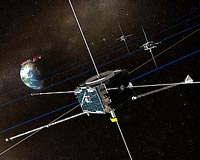 |
Richmond VA (SPX) Feb 14, 2011 An international team of researchers has discovered a new class of magnetic superhalogens - a class of atomic clusters able to exhibit unusual stability at a specific size and composition, which may be used to advance materials science by allowing scientists to create a new class of salts with magnetic and super-oxidizing properties not previously found. The discovery, which was published Feb. 10 in the Early View issue of the international chemistry journal Angewandte Chemie International Edition, was based on theoretical work by researchers from Virginia Commonwealth University, McNeese State University, and Peking University in China, and experimental work at Johns Hopkins University. Unlike conventional superhalogens that are composed of a metal atom at the core and surrounded by halogen atoms, the magnetic superhalogens discovered by this team are composed of stoichiometric metal-halogen moieties at the core to which an additional halogen is attached. The new chemical species known as magnetic superhalogens mimic the chemistry of halogens which are a class of elements from the periodic table, namely, iodine, astatine, bromine, fluorine and chlorine. The word halogen means "salt-former," and when one of the elements above combines with sodium, they can form a salt. Specifically, the cluster is MnxCl2x+1, where x = 1, 2, 3, and so on, have manganese and chlorine atoms as a core to which only one chlorine atom is attached. The manganese atoms carry a large magnetic moment and therefore make these superhalogens magnetic. "One can now design and synthesize yet unknown magnetic superhalogens by changing the metal atom from manganese to other transition metal atoms and changing chlorine to other halogen atoms. In addition to their use as oxidizing agents, being magnetic opens the door to the synthesis a new class of salts," said lead investigator Puru Jena, Ph.D., distinguished professor of physics at VCU. According to Jena, superhalogens are like halogens, in the sense they form negative ions, but their affinity to attract electrons is far greater than those of any halogen atoms. Negative ions are useful as oxidizing agents, for purification of air and in serotonin release for uplifting mood. "Superhalogens can do the same thing as halogens can do, only better," said Jena. "The ability of superhalogens to carry large quantities of fluorine and chlorine can be used for combating biological agents as well." "In addition, superhalogens, due to their large electron affinity, can involve inner core electrons of metal atoms in chemical reaction, thus fundamentally giving rise to new chemistry," said Jena. In October, Jena and his colleagues reported the discovery of a new class of highly electronegative chemical species called hyperhalogens, which use superhalogens as building blocks around a metal atom. The chemical species may have application in many industries. Jena collaborated with researchers Qian Wang, Ph.D., with the Department of Physics at VCU; Kiran Boggavarapu, Ph.D., with the Department of Chemistry at McNeese State University, and Anil K. Kandalam, Ph.D., with the Department of Physics at McNeese State University; Qiang Sun, Ph.D., and graduate student, Miao Miao Wu, with VCU's Department of Physics at Peking University; and Haopeng Wang and Yeon Jae Ko, both graduate students, and Kit H. Bowen, Ph.D., all with the Department of Chemistry at Johns Hopkins University.
Share This Article With Planet Earth
Related Links Virginia Commonwealth University Understanding Time and Space
 Tracking The Origins Of Speedy Space Particles
Tracking The Origins Of Speedy Space ParticlesGreenbelt MD (SPX) Feb 01, 2011 NASA's Time History of Events and Macroscale Interaction during Substorms (THEMIS) spacecraft combined with computer models have helped track the origin of the energetic particles in Earth's magnetic atmosphere that appear during a kind of space weather called a substorm. Understanding the source of such particles and how they are shuttled through Earth's atmosphere is crucial to better un ... read more |
|
| The content herein, unless otherwise known to be public domain, are Copyright 1995-2010 - SpaceDaily. AFP and UPI Wire Stories are copyright Agence France-Presse and United Press International. ESA Portal Reports are copyright European Space Agency. All NASA sourced material is public domain. Additional copyrights may apply in whole or part to other bona fide parties. Advertising does not imply endorsement,agreement or approval of any opinions, statements or information provided by SpaceDaily on any Web page published or hosted by SpaceDaily. Privacy Statement |